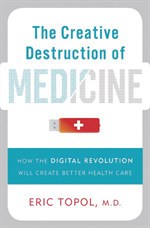
Title: The Creative Destruction of Medicine:
How the Digital Revolution Will Create Better Health Care
Author: Eric Topol, MD
Publisher: Basic Books
Publication date: February 1, 2012
Price: $27.99 / $31.00 (CAN), Hardcover,
320 pages
More information:
http://creativedestructionofmedicine.com/
“This is a new era of medicine, in which each individual can be near fully defined at the individual level, instead of how we practice medicine at a population level, with mass screening policies for such conditions as breast or prostate cancer…” Eric Topol, MD, Chief Academic Officer of Scripps Health writes in The Creative Destruction of Medicine. His provocative new book adroitly makes a case for dramatic transformation of our bloated, inefficient health-care system and challenges his colleagues to become “doctors with plasticity,” embracing the next frontier of the digital revolution.
Dr. Topol is a big thinker, a visionary, but unlike many big-thinking visionaries, he doesn’t languish in the comfort zone of theory. He provides a blueprint and tools, rolls up his sleeves, and gets to work building a better health-delivery system. “Creative destruction”—a term popularized by Austrian economist Joseph Schumpeter to denote change with radical innovation—serves well as a descriptor for this unabashedly frank book, constructed in three information-stuffed, problem-solving parts.
Part I lays the foundation for the digital convergence that Dr. Topol asserts will “define the essential characteristics of each individual—the high-definition human—setting up a unique era of medicine.” Dr. Topol’s riveting case histories sharpen his argument as he dissects our sacred medical cows: evidence-based medicine, randomized controlled trials, and mass screening for breast and prostate cancers. The message, which resonates throughout the text, is that today’s doctors are flying biplanes in the jet age.
Part II, denser than part I, is about capturing and using data. Dr. Topol makes it clear that all data are not created equal. He accurately portrays the promise and problems with electronic health records and how they will evolve into the future of personal health records. Again, it’s all about the individual. He ends with hard-hitting clinical facts about melding digital technology and data into actionable, precise medicine.
Part III examines rebooting the life science industry and the way doctors look at their trade. The underlying message, colored with a bit of collegial advice, is that new tools drive new models—watch for a steady demise of hospitals and clinics, as we know them. Dr. Topol is never strident, but he doesn’t pull punches: “I expect some 50% to 70% of office visits to be replaced by remote monitoring, digital health records, and virtual house calls.”
Dr. Topol’s book doesn’t warn; it invites us into a future where new technology improves the outlook for chronic diseases and shifts the capability, for the first time, to true prevention. If the book has a flaw, perhaps it goes on a tad too long in some of the didactic sections. But that’s a small gripe for a work that truly brings light to the end of our muddled health-care tunnel. ■

